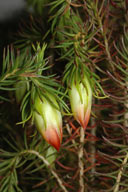In Flower This Week
A weekly news sheet prepared by a Gardens' volunteer.
Numbers before each plant refer to temporary IFTW labels in the gardens.
Numbers in square brackets [ ] refer to garden bed Sections. Plants in flower are in bold type.
View past issues of 'In Flower This Week'.
19 October 2012
Darwinia wittwerorum click for larger image |
Today we walk along the Main Path which is packed with plants in flower
- Dampiera latealata [Section 221] in a pot has pendent purple flowers on lax winged foliage
- Podolepis monticola [Section 174] is a bright yellow daisy on rosettes of greyish green ovate foliage.
- Hibbertia empetrifolia [Section 210] has masses of bright yellow coin flowers on wiry trailing foliage.
- Another hibbertia, this time in a pot, Hibbertia stellaris [Section 174] or Orange Stars has orange flowers with red stems on bright green foliage.
- Go across the bridge and turn uphill to see a pot of Calytrix glutinosa [Section 11] with pinkish-mauve star flowers on a small neat bush.
- Darwinia wittwerorum [Section 10] has pendent bell flowers of yellow tipped with red on close, soft foliage. This is a threatened species in the wild.
- Homoranthus sp. aff. flavescens [Section 9] has acid yellow clusters of bloom with long stamens on light green foliage.
- Bulbine glauca [Section 303] has cheerful yellow spires of bloom on iris-like foliage.
- Teleopea ‘Canberry Gem’ [Section 30] is a magnificent large pyramidal bush covered in bright pink waratah flowers.
- Homoranthus montanus [Section 30] is an airy bush with bright pink buds opening to yellow four part flowers.
- Grevillea monticola [Section 30] is a small bush with holly-like foliage and cream cluster flowers.
- A patch of the spreading groundcover Grevillea ‘Bronze Rambler’ [Section 27] forms a thick mat of stiff divided foliage with red toothbrush flowers.
- Isopogon anemonifolius [Section 25] shows a bank of bright green pine-like foliage with yellow cones of flower.
- Grevillea ‘Flame ‘n Beauty’ [Section 25] has grey foliage with pendent pink blooms with prominent red stamens.
- Grevillea mucronulata[Section 25] has insignificant greenish flowers with long brown stamens on close curled mid-green foliage. Bees love these flowers.
- Grevillea dimorpha [Section 25] is a mass of showy red blooms clustered along the stems of contrasting dark green foliage.
- Grevillea acanthifolia subsp. acanthifolia [Section 27] has large pink toothbrush flowers on prickly yellow-green foliage.
- Grevillea australis ‘Cara Lynn’ [Section 25] is a large bush with masses of sweetly scented curled white flowers.
- Grevillea ilicifolia subsp. ilicifolia [Section 25] is a dense groundcover with masses of dark red toothbrush blooms.
- Grevillea flexuosa [Section 25] has many sweetly scented cream rods of flower on prickly divided foliage.
- Hakea rostrata [Section 24] has curled white clusters of flowers along the stems on a bush with long thin hard leaves
- Isopogon formosus subsp. formosus [Section 26] has bright mauve pink mop head flowers on thin foliage.
- Grevillea lavandulacea [Section 26] has bright pink and cream flowers massed on grey pine-like foliage.
- Grevillea sericea [Section 26] has light pink flowers with long darker pink stamens.
- Grevillea ‘Bonfire’ [Section 24] is a large dense bush with attractive fine foliage and many red waxy flowers.
Rosalind Walcott.
![Director of National Parks [logo]](../../../../images/dnp_90px.gif)







